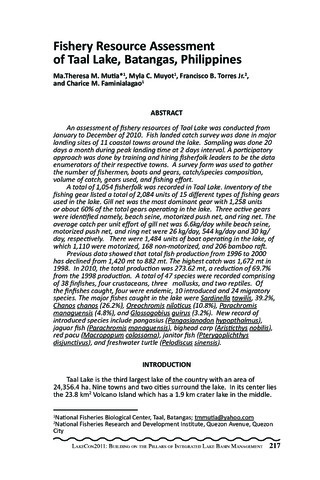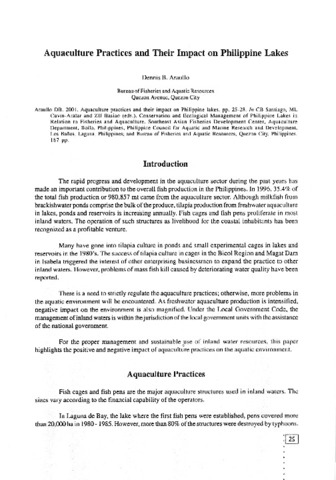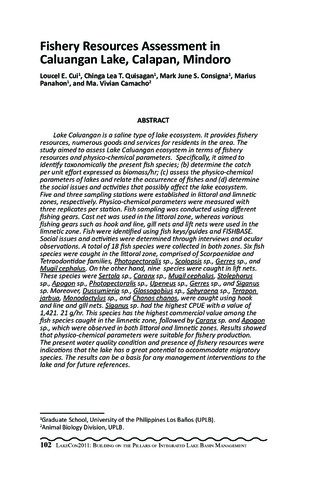The decline of native fishes and fisheries and the rise of aquaculture in lakes and rivers in the Philippines
- Global styles
- MLA
- Vancouver
- Elsevier - Harvard
- APA
- Help

日付
2001Page views
11,934ASFA keyword
AGROVOC keyword
Taxonomic term
Geographic names
Metadata
アイテムの詳細レコードを表示する
Share
抄録
This paper reviews historical and recent data on biodiversity, fisheries, exotic fishes, and aquaculture in Philippine lakes and rivers. The country's lakes and rivers are poor in primary freshwater fishes because the Philippines' only connection with the Asian mainland had been through land bridges between Borneo, the Sulu islands, Mindanao, Palawan and Mindoro - in which islands endemic carps have evolved. Philippine lakes and rivers instead have secondary freshwater fishes such as gobies, migratory marine fishes such as mullets, and some snails, clams, and prawns. Most lakes and rivers have been severely degraded and their biodiversity reduced by siltation, pollution, overfishing, and the establishment of exotic fishes from other countries or elsewhere in the country. Many fishes first described in the Philippines in 1910-1940 by Seale, Herre, and Filipino ichthyologists have not been collected in recent years. The Laguna de Bay fishery in the early 1960s was largely dependent on the 'ayungin' Therapon plumbeus, 'biyang puti' Glossogobius giurus, and the 'kanduli' Arius manilensis that together comprised 95% of the annual 83,000 mt; another 19,000 mt came from shrimps and 245,000 mt from snails. Fishing and snail-dredging were so intense that catches declined and the whole lake fishery collapsed around 1970. After the collapse, the primary production of the lake increased and milkfish and tilapia became natural choices for aquaculture. Lake Lanao became famous for its species flock of 18 endemic carps, but these are now extinct, except perhaps two species. In 1963, these carps contributed 981 mt to the fishery, other native fishes 269 mt, shrimps and snails 257 mt, and introduced fishes 479 mt. Twenty years later, endemic carps have made up only 92 mt, native fishes 141 mt, shrimps and snails 164 mt, and introduced fishes 312 mt of the harvest from the lake. The 'kadurog' G. giurus, probably stocked in the lake with milkfish larvae in 1955, proliferated in the 1960s and apparently drove the endemic carps to extinction. The 'katolong' Hypseleotris agilis was first seen in the lake in 1977 and has since outcompeted the 'kadurog'. In Lakes Taal and Naujan, migratory marine fishes have been caught by fish corrals set across the outlets, but the catch along Pansipit River has fallen since the turn of the century and that in Butas River fell from 62 mt in 1977 to 17 mt in 1983. Catches of the endemic sardine Harengula tawilis in Lake Taal fluctuated between 4,400 mt in 1983 to 11,300 mt in 1990 and 1,400 mt in 1994. Cage culture of tilapia and milkfish has been going on in Lake Taal for 10 years. In Lakes Buhi and Bato, the endemic 'sinarapan' Mistichthys luzonensis almost disappeared due to fine-net fishing and tilapia stocking; catches have been 50-90 mt in 1983-93 but zero in 1994.
記述
Abstract only.
Suggested Citation
Bagarinao, T. U. (2001). The decline of native fishes and fisheries and the rise of aquaculture in lakes and rivers in the Philippines (Abstract only). In C. B. Santiago, M. L. Cuvin-Aralar & Z. U. Basiao (Eds.), Conservation and Ecological Management of Philippine Lakes in Relation to Fisheries and Aquaculture (p. 151). Tigbauan, Iloilo, Philippines: Aquaculture Department, Southeast Asian Fisheries Development Center; Los Baños, Laguna, Philippines: Philippine Council for Aquatic and Marine Research and Development (PCAMRD), Department of Science and Technology; Quezon City, Philippines: Bureau of Fisheries and Aquatic Resources (BFAR), Department of Agriculture, Quezon City, Philippines.
Type
Conference paperISBN
9718511539
Related items
Showing items related by title, author, creator and subject.
-
Series: Summary of Proceedings No. 1/2013;
Fishery resource assessment of Taal Lake, Batangas, Philippines
Mutia, Ma. Theresa M.; Muyot, Myla C.; Torres Jr., Francisco B.; Faminialagao, Charice M. (PCAARRD-DOST, 2013)An assessment of fishery resources of Taal Lake was conducted from January to December of 2010. Fish landed catch survey was done in major landing sites of 11 coastal towns around the lake. Sampling was done 20 days a month ... -
Aquaculture practices and their impact on Philippine Lakes
Araullo, Dennis B. (Aquaculture Department, Southeast Asian Fisheries Development Center; Philippine Council for Aquatic and Marine Research and Development (PCAMRD), Department of Science and Technology; Bureau of Fisheries and Aquatic Resources, 2001)The rapid progress and development in the aquaculture sector during the past years has made an important contribution to the overall fish production in the Philippines. In 1996, 35.4% of the total fish production or 980,857 ... -
Series: Summary of Proceedings No. 1/2013;
Fishery resources assessment in Caluangan Lake, Calapan, Mindoro
Cui, Loucel E.; Quisagan, Chinga Lea T.; Consigna, Mark June S.; Panahon, Marius; Camacho, Ma. Vivian (PCAARRD-DOST, 2013)Lake Caluangan is a saline type of lake ecosystem. It provides fishery resources, numerous goods and services for residents in the area. The study aimed to assess Lake Caluangan ecosystem in terms of fishery resources and ...





